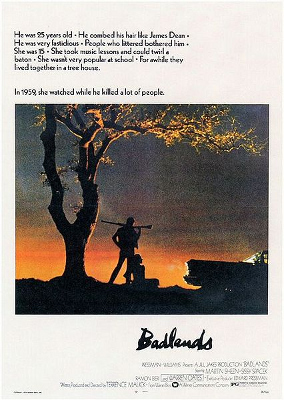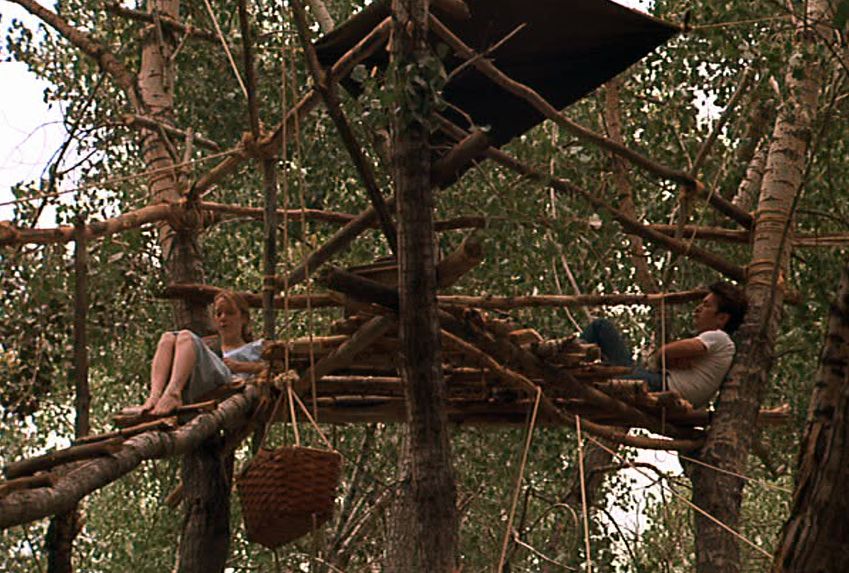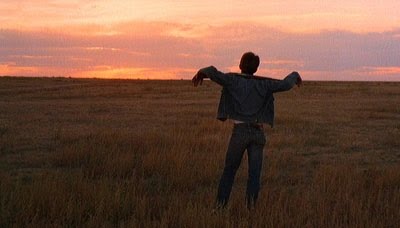To give the impending Smackdown some context, we're looking at films from 1973. Here's Abstew on a spectacular debut...
 With only a half dozen films released over the past 40 years, director Terrence Malick has already earned his place among the greatest American filmmakers. Despite his relatively small filmography, he has carved out a distinct brand of filmmaking that inspires (sometimes as much as it confuses or bores). But before he was an admired and respected filmmaker, he was just a former Rhodes scholar that graduated from Harvard working as a philosophy professor at MIT. His first film, Badlands, began to take take shape as he studied film at the American Film Institute. It was immediately hailed by critics on its initial release in 1973, where it was the closing night film at the New York Film Festival. That year's festival also saw the debut of Martin Scorsese's Mean Streetsm proving that 1973 was not only a very good year for film, but a landmark year for new voices. Both films were sold to Warner Brothers on the same day.
With only a half dozen films released over the past 40 years, director Terrence Malick has already earned his place among the greatest American filmmakers. Despite his relatively small filmography, he has carved out a distinct brand of filmmaking that inspires (sometimes as much as it confuses or bores). But before he was an admired and respected filmmaker, he was just a former Rhodes scholar that graduated from Harvard working as a philosophy professor at MIT. His first film, Badlands, began to take take shape as he studied film at the American Film Institute. It was immediately hailed by critics on its initial release in 1973, where it was the closing night film at the New York Film Festival. That year's festival also saw the debut of Martin Scorsese's Mean Streetsm proving that 1973 was not only a very good year for film, but a landmark year for new voices. Both films were sold to Warner Brothers on the same day.
Set in South Dakota in the 1950s and loosely based on the real-life incident of Charles Starkweather who went on a killing spree with his teenage girlfriend in 1958, Badlands follows former garbage man Kit Carruthers (played by Martin Sheen in the role that established his own career in film, having working almost exclusively in television up until then) as he and his 15-year-old girlfriend Holly (Sissy Spacek in only her second film) take off cross-country after Kit kills Holly's disapproving father. Although seen as rebels (Kit is often compared to the original rebel without a cause, James Dean), the two are more simple-minded than that. They seem to be going along for a ride not quite knowing what they're doing or why exactly they're doing it.

Malick has described the film as a sort of fairy tale and despite the often cited influence of Arthur Penn's Bonnie and Clyde, the films don't really share much more than a vaguely familiar story outline. But while Bonnie and Clyde have a sexual energy and a glamorization of the robbers as they steal Robin Hood-like from the rich to give to the poor, Kit and Holly behave more like the children they are. After their first sexual encounter Holly asks aloud if that's all there is and the two never seem to be interested in it from that point on. Malick has said the main influence was children's fantasy books like Treasure Island and Swiss Family Robinson (and from the elaborate treehouse the fugitives build in the most surreal part of the film, you can certainly see that influence). The kind of stories that had child-like wonder but very real danger. Despite the murders that Kit commits, none of it ever seems to register for him as an act of killing. Malick told Sheen that Kit sees the gun as a magic wand that erases all troubles without thinking of them. As the film progresses and the body count gets higher, neither Kit nor Holly ever feel remorseful for what they've done. But rather than feel anger at their lack of self awareness, we mainly feel pity that they're so out of touch with basic human emotions.
Malick's style was established almost immediately with Badlands. The techniques and storytelling devices were there from the beginning: the use of voice over, the lingering shots of nature, and a tendency to favor mood and atmosphere over traditional narrative. But Badlands is also Malick's most accessible film. In his most focused and traditionally structured film, the voice over, rather than in later films were it becomes abstract and poetic, is used to advance the story and give insight to the characters. And unlike subsequent films that rely almost exclusively on the voice over, Badlands is filled with dialogue between its characters, oftentimes more humorous or light-hearted from what we'd expect from a Malick film. The camera, while still catching Malick's fascination with the environment, doesn't rest too long before we've joined our main characters on their journey again. And, of course, there's Malick's love of light and what would become a trademark (especially in his next film Days of Heaven), filming during Golden Hour. In fact, perhaps the most famous shot of the film, with Sheen holding the rifle behind his neck in an almost Christ-like pose as the sun sets, was not a shot initially in the script, but came about because Malick loved the light at that certain moment and wanted to capture it for his film.

Although the critical success gave Malick carte blanche from the studios to make the type of art films he wanted, the freedom became almost too much for him to handle. After the release of Badlands he refused to do any interviews and photos of him became even harder to come by. (Malick does make an appearance himself in Badlands as the visitor to the home of the rich man Kit and Holly hold hostage.) He would spend over 2 years editing 1978's Days of Heaven and didn't make another film for almost 20 years. Although he seems to have gained some newfound inspiration, becoming almost downright prolific having filmed three films over the past couple years after the back-to-back release of The Tree of Life (2011) and To the Wonder (2013), but none of those films have an anticipated release date. Which makes me wonder if they'll ever see the light of day. Even if we only ever have the six films that he has released as the testament to his talent, we owe it all to Badlands. It was the film that signaled the arrival of a cinematic icon.